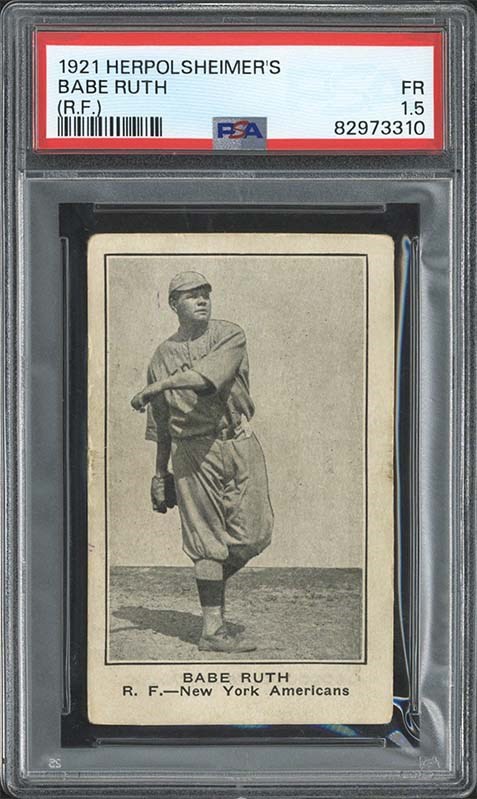In the exciting and ever-evolving world of sports memorabilia collecting, a surprising and remarkable discovery has emerged, shedding new light on the fascinating history of early baseball cards. Tucked away in the most unexpected place—a Band-Aid box—an extraordinary find was made: a collection of 39 cards from the elusive 1921 Herpolsheimer set, including nine cards that were previously unknown to collectors and enthusiasts. These hidden treasures, which have been concealed for close to a century, have now been unveiled and are set to be auctioned off in Love of the Game Auctions’ ongoing event.
The Herpolsheimer cards, issued in 1921, have long been regarded as some of the rarest and most coveted in the world of baseball card collecting. With only 105 cards from this set having been authenticated and graded across both the PSA and SGC population reports, this recent discovery not only expands the known universe of these cards but also enriches it with new and previously unseen faces.
Al Crisafulli, the auction director at Love of the Game, could hardly contain his excitement when discussing this find. “I’ve been captivated by these cards for years,” he shared, conveying a sentiment that is shared among serious collectors who understand the rarity and historical importance of the Herpolsheimer issue.
The story behind this remarkable find is just as intriguing as the cards themselves. In 2019, at an estate sale not far from Grand Rapids, Michigan, these cards were stumbled upon tucked inside a humble Band-Aid box, a seemingly mundane container that held a small fortune in paper treasures. After maintaining contact with the card owner for four years, Crisafulli finally secured these gems for auction. Each card has since been graded by PSA and will be auctioned off individually, ensuring that their historical significance and value are properly recognized and celebrated.
Among the impressive haul is a card featuring none other than Babe Ruth, a player whose legend looms large in the world of baseball. This particular card is only the second of its kind known to exist, making it an exceedingly rare and highly sought-after piece. Given the scarcity of Babe Ruth cards and his iconic status, this card alone is expected to command a significant price at auction. Additionally, the newfound collection includes cards featuring other legendary Hall of Famers such as Tris Speaker, Grover Cleveland Alexander, Rabbit Maranville, John McGraw, Red Faber, and Sam Rice, further solidifying the importance and significance of this discovery.
What makes these cards even more fascinating is the information found on the back. These cards serve as advertisements for the Grand Rapids retail store’s Boy’s Fashion Shop, adding an extra layer of historical context and interest. The discovery of additional cards not listed in the original checklist, including Dave Bancroft, Johnny Evers, Harry Hooper, Stuffy McInnis, Art Nehf, Wally Schang, George Sisler, Casey Stengel, and Fred Toney, suggests that the Herpolsheimer set may be larger than previously believed. It is now speculated that the set may actually comprise 78 or 79 cards, rather than the previously accepted count of 69 or 70.
Crisafulli first became aware of these cards in 2019 when the owner discreetly inquired about their value on the Net54 sports card forum, piquing the curiosity of both forum members and Crisafulli himself. This initial contact led to a continued dialogue, ultimately resulting in the cards being consigned to the upcoming auction.
The history of the Herpolsheimer Company, the organization behind these cards, is as rich and diverse as the cards themselves. Founded in 1870 as a dry goods store by William Godlove Herpolsheimer and Charles G.A. Voigt, the company quickly became a prominent presence in Grand Rapids and beyond. Over the years, the business passed through the hands of Henry Herpolsheimer and his son Arthur, who oversaw a merger and expanded into furniture sales. Sadly, Arthur’s life ended prematurely, adding a touch of melancholy to the family’s legacy.
The store’s impact even extended into national history, as Betty Bloomer, who would later become the First Lady as the wife of President Gerald R. Ford, worked as a fashion coordinator at Herpolsheimer in 1942.
The discovery of this second batch of Herpolsheimer cards alters the narrative surrounding their distribution and significance, hinting at a wider release than previously believed. It paints a picture of a department store that used the appeal of baseball’s most celebrated figures to connect with and attract customers.
The Band-Aid box that sheltered these historic cards, a relic from the 1930s, serves as a poignant reminder of the journey these cards have undertaken—from promotional items in a local store to cherished and highly sought-after artifacts in the world of collectibles.
As the auction date draws nearer, these cards are poised to captivate the collecting community, offering a rare glimpse into the early days of baseball card collection. Each card, with its faint pencil markings and signs of wear from decades of handling, weaves a unique narrative that collectors will soon have the opportunity to continue as they become the fortunate new guardians of these invaluable pieces of baseball history.

